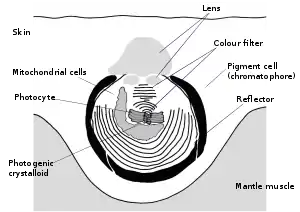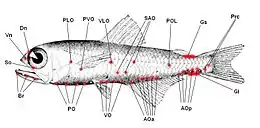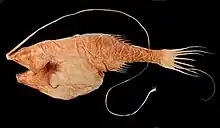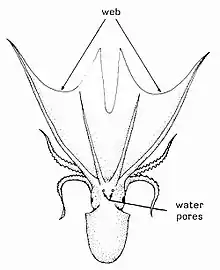.JPG.webp)

A photophore is a glandular organ that appears as luminous spots on various marine animals, including fish and cephalopods. The organ can be simple, or as complex as the human eye; equipped with lenses, shutters, color filters and reflectors, however unlike an eye it is optimized to produce light, not absorb it.[1] The bioluminescence can variously be produced from compounds during the digestion of prey, from specialized mitochondrial cells in the organism called photocytes ("light producing" cells), or, similarly, associated with symbiotic bacteria in the organism that are cultured.
The character of photophores is important in the identification of deep sea fishes. Photophores on fish are used for attracting food or for camouflage from predators by counter-illumination.
Photophores are found on some cephalopods including the firefly squid, which can create impressive light displays, as well as numerous other deep sea organisms such as the pocket shark Mollisquama mississippiensis and the strawberry squid.[1][2]
 Arrangement of various photophores on the squid Lycoteuthis lorigera
Arrangement of various photophores on the squid Lycoteuthis lorigera Photophores on a lanternfish, the most common deep sea fish worldwide
Photophores on a lanternfish, the most common deep sea fish worldwide This anglerfish has a dorsal fin whose first ray has become very long and is tipped with a luminous photophore fishing lure
This anglerfish has a dorsal fin whose first ray has become very long and is tipped with a luminous photophore fishing lure
See also
- Bioluminescence
- Chromatophore
- Chromophore, part of a molecule
References
- 1 2 "Cephalopod Photophore Terminology". Tolweb.org. Retrieved 2012-08-30.
- ↑ Scribner, Herb (2019-07-23). "This glow-in-the-dark shark was recently discovered. Here's what we know". Deseret News. Retrieved 2020-08-06.





